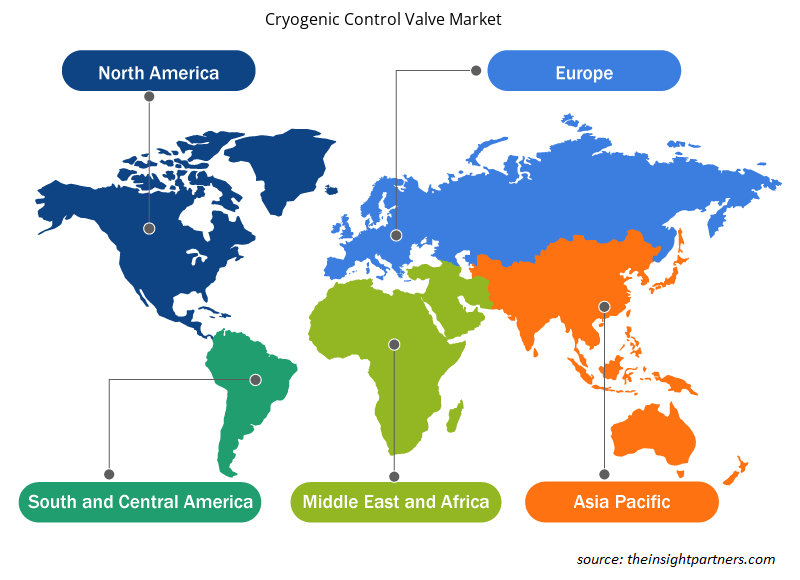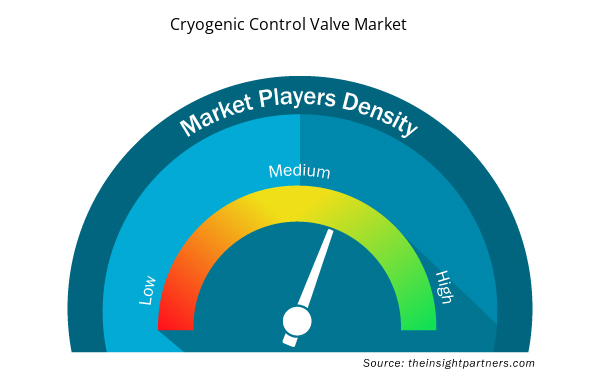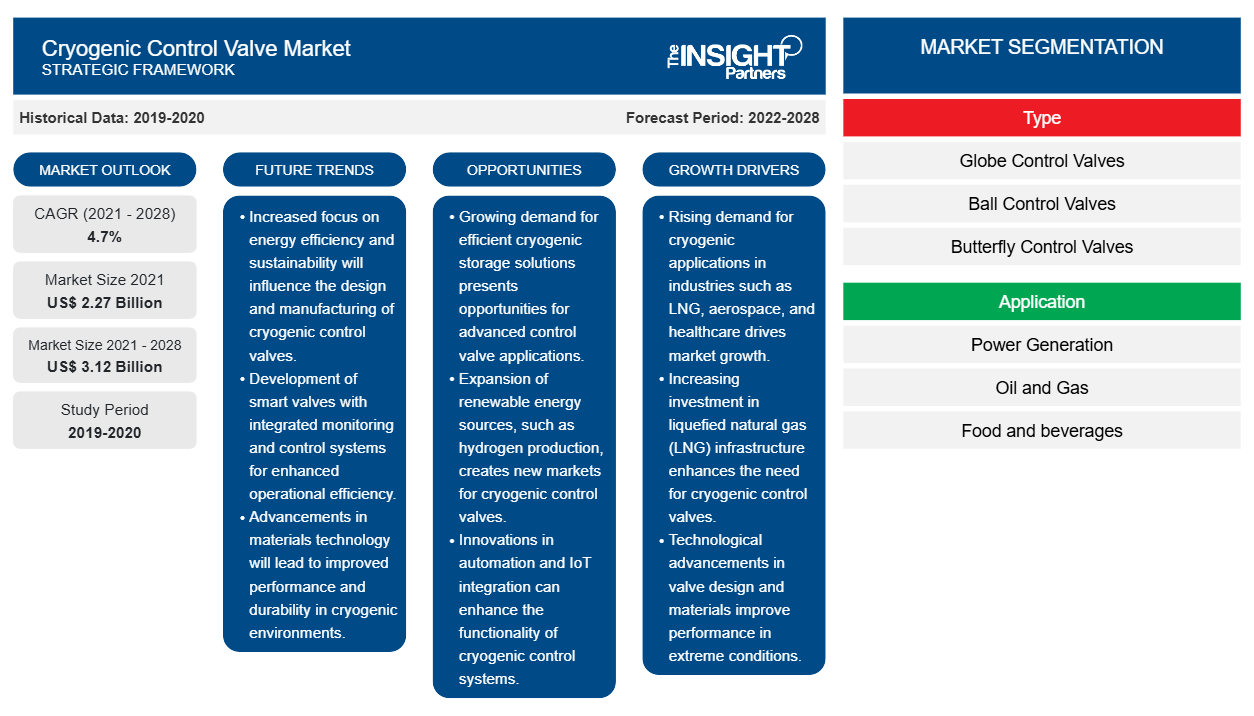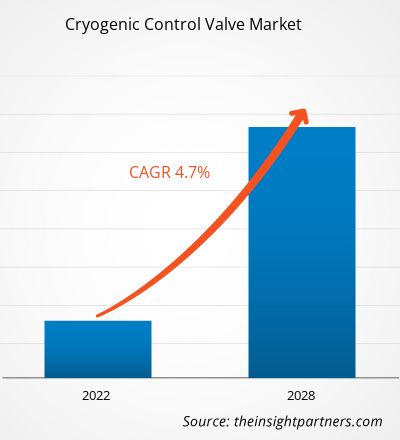극저온 제어 밸브 시장은 2021년 2,267.07백만 달러에서 2028년 3,117.79백만 달러로 성장할 것으로 예상되며, 2021~2028년 동안 연평균 성장률 4.7%로 성장할 것으로 추산됩니다.
영국, 미국, 호주, 독일, 인도, 중국 등 선진국과 개발도상국에서 산업용 가스에 대한 수요가 증가하고 있습니다. 다양한 산업의 특정 용도에 맞게 다양한 산업용 가스가 생산됩니다. 주로 사용되는 산업용 가스로는 산소, 질소, 아르곤, 이산화탄소, 헬륨, 수소, 아세틸렌 등이 있습니다. 극저온 밸브는 압축 천연 가스(CNG) 및 액화 천연 가스(LNG)와 같은 액화 가스의 운송, 사용 및 보관에 널리 사용됩니다. 인도에서 CNG 자동차 판매는 2021 회계연도에 전년 대비 49% 성장을 기록했으며 시장 점유율은 2020년 4%에서 2021년 6%로 증가했습니다. 액체 질소와 같은 액화 가스에 대한 수요는 피부 이상 제거를 위한 극저온 요법, 식품 운송 및 냉동, 초전도체 냉각, 혈액의 극저온 보존에서 증가하고 있습니다.
산소 생산을 위해 극저온 밸브는 대규모 공기 분리 플랜트에서 사용됩니다. 최근 산소에 대한 수요 증가도 극저온 제어 밸브 시장 성장에 기여하는 원동력입니다. 가스 산업에 필요한 다양한 유형의 극저온 밸브는 게이트 밸브, 체크 밸브, 글로브 밸브, 리프트 체크 밸브, 볼 밸브, 핀치 밸브, 스톱 체크 밸브, 버터플라이 밸브, 틸팅 디스크 체크 밸브, 플러그 밸브, 다이어프램 밸브, 안전 밸브 및 압력 방출 밸브입니다. 화학, 석유화학, 제강, 광업, 환경 보호, 금속, 의학, 생명 공학, 제약 등과 같은 다양한 산업에서 산업용 가스에 대한 수요가 증가함에 따라 언급된 밸브에 대한 수요도 상당히 증가할 것으로 예상됩니다.
귀하의 요구 사항에 맞게 이 보고서를 사용자 정의하세요
이 보고서의 일부 또는 국가 수준 분석, Excel 데이터 팩을 포함하여 모든 보고서에 대한 사용자 정의를 무료로 받을 수 있으며 신생 기업 및 대학을 위한 훌륭한 혜택과 할인 혜택을 이용할 수 있습니다.
- 이 보고서의 주요 시장 동향을 알아보세요.이 무료 샘플에는 시장 동향부터 추정 및 예측까지 다양한 데이터 분석이 포함됩니다.
COVID-19 팬데믹이 극저온 제어 밸브 시장에 미치는 영향
COVID-19 팬데믹은 공급망 활동의 상당한 중단과 여러 국가가 팬데믹의 여파로 국제 무역을 봉쇄하면서 전반적인 석유 및 가스 산업에 부정적인 영향을 미쳤습니다. 또한, 제한된 수요와 석유 생산국의 지속적인 생산으로 인해 글로벌 석유 및 가스 가격이 크게 폭락하여 주요 석유 생산국에서 생산 활동이 상당히 감소했습니다. 결과적으로 석유 및 가스 활동의 중단으로 인해 저온 밸브와 같은 관련 제품 및 서비스에 대한 수요가 중단되었습니다.
COVID-19 팬데믹 속에서 소비재에 대한 수요 급증으로 인해 식품 가공 사업이 상당히 증가했습니다. 이러한 발전은 어느 정도 저온 밸브 사용을 안정화했습니다. 따라서 팬데믹은 2020년 1~2분기 동안 저온 제어 밸브 시장에 부정적인 영향을 미쳤습니다. 그러나 경제 활동이 지속되면서 수요가 회복되었습니다. 따라서 글로벌 시장은 앞으로 몇 달과 그 이후 몇 년 동안 수요 부족을 회복할 것으로 예상됩니다.
극저온 제어 밸브 시장 통찰력
FSRU 및 FPSO에 대한 수요 증가로 극저온 제어 밸브 시장 성장 촉진
최근 들어, 부유 생산 저장 하역(FPSO) 장치와 부유 저장 재기화 장치(FSRU)에 대한 수요가 상당한 수준으로 증가했습니다. FPSO 장치는 석유 및 가스 산업에서 탄화수소와 석유 저장을 처리하고 생산하는 데 널리 사용됩니다. 해양 채널을 통해 액화 천연 가스(LNG)를 이송하고 전환하려면 FSRU가 필요합니다. 석유 수출국 기구(OPEC)에 따르면, 세계 석유 수요는 2002년부터 2025년까지 하루 3,800만 배럴에서 하루 1억 1,500만 배럴로 증가할 것으로 예상되며, 연평균 성장률은 하루 160만 배럴 또는 1.7%입니다. 기술적 타당성, 이동성, 가용성, 일정, 상업적 유연성 및 낮은 비용을 고려할 때 FSRU는 전 세계적으로 인기를 얻고 있습니다. 천연 가스 사용이 증가함에 따라 아시아 태평양은 향후 몇 년 동안 가장 큰 FSRU 시장이 될 것으로 예상됩니다. 각 유형의 극저온 밸브는 FPSO 장치와 FSRU에서 널리 사용됩니다. 이는 전 세계적으로 극저온 밸브 시장을 주도할 것으로 예상됩니다.
유형 기반 시장 통찰력
유형에 따라, 저온 제어 밸브 시장은 글로브 제어 밸브, 볼 제어 밸브, 버터플라이 제어 밸브 및 기타로 세분화됩니다. 2020년에는 기타 세그먼트가 가장 큰 시장 점유율을 차지했습니다.
애플리케이션 기반 시장 통찰력
응용 프로그램을 기준으로, 저온 제어 밸브 시장은 발전, 석유 및 가스, 식품 및 음료, 기타 응용 분야로 세분화됩니다. 2020년에는 석유 및 가스 부문이 가장 큰 시장 점유율을 차지했습니다.
극저온 제어 밸브 시장에서 활동하는 업체들은 시장에서의 입지를 유지하기 위해 합병, 인수, 시장 이니셔티브와 같은 전략을 채택합니다. 주요 업체들의 몇 가지 개발 사항은 다음과 같습니다.
- 2021년 6월, Baker Hughes와 Borg CO2는 탄소 포집 및 저장 프로젝트에 대한 협력에 관한 양해각서를 발표했습니다. 이 프로젝트는 노르웨이 비켄 지역의 산업 공간 탈탄소화 허브 역할을 할 것입니다.
- 에머슨은 2021년 3월, 유체 제어 성능에 영향을 주지 않으면서 더욱 컴팩트한 장비와 기계를 개발하려는 OEM의 요구를 충족하는 일련의 3방향 및 2방향 솔레노이드 밸브를 출시했습니다.
극저온 제어 밸브 시장 지역 통찰력
Insight Partners의 분석가들은 예측 기간 동안 저온 제어 밸브 시장에 영향을 미치는 지역적 추세와 요인을 철저히 설명했습니다. 이 섹션에서는 북미, 유럽, 아시아 태평양, 중동 및 아프리카, 남미 및 중미의 저온 제어 밸브 시장 세그먼트와 지리에 대해서도 설명합니다.

- 극저온 제어 밸브 시장에 대한 지역별 특정 데이터 얻기
극저온 제어 밸브 시장 보고서 범위
| 보고서 속성 | 세부 |
|---|---|
| 2021년 시장 규모 | 22억 7천만 달러 |
| 2028년까지 시장 규모 | 31억 2천만 달러 |
| 글로벌 CAGR (2021-2028) | 4.7% |
| 역사적 데이터 | 2019-2020 |
| 예측 기간 | 2022-2028 |
| 다루는 세그먼트 | 유형별로
|
| 포함된 지역 및 국가 | 북아메리카
|
| 시장 선도 기업 및 주요 회사 프로필 |
|
극저온 제어 밸브 시장 참여자 밀도: 비즈니스 역학에 미치는 영향 이해
극저온 제어 밸브 시장은 소비자 선호도의 변화, 기술 발전, 제품의 이점에 대한 인식 증가와 같은 요인으로 인해 최종 사용자 수요가 증가함에 따라 빠르게 성장하고 있습니다. 수요가 증가함에 따라 기업은 제품을 확장하고, 소비자의 요구를 충족하기 위해 혁신하고, 새로운 트렌드를 활용하여 시장 성장을 더욱 촉진하고 있습니다.
시장 참여자 밀도는 특정 시장이나 산업 내에서 운영되는 회사나 기업의 분포를 말합니다. 주어진 시장 공간에 얼마나 많은 경쟁자(시장 참여자)가 존재하는지 그 규모나 총 시장 가치에 비해 나타냅니다.
극저온 제어 밸브 시장에서 운영되는 주요 회사는 다음과 같습니다.
- 베이커 휴즈 회사
- 에머슨 일렉트릭(주)
- 플로우서브 코퍼레이션
- 주식회사 벨란
- (주)코발
면책 조항 : 위에 나열된 회사는 어떤 특별한 순서에 따라 순위가 매겨지지 않았습니다.

- 극저온 제어 밸브 시장 주요 업체 개요를 알아보세요
글로벌 극저온 제어 밸브 시장은 아래와 같이 세분화되었습니다.
유형별로
- 글로브 컨트롤 밸브
- 볼 컨트롤 밸브
- 버터플라이 컨트롤 밸브
- 기타
응용 프로그램으로
- 발전
- 석유 및 가스
- 음식과 음료
- 다른 응용 프로그램
지리별로
- 북아메리카
- 우리를
- 캐나다
- 멕시코
- 유럽
- 프랑스
- 독일
- 이탈리아
- 영국
- 러시아 제국
- 유럽의 나머지 지역
- 아시아 태평양(APAC)
- 중국
- 인도
- 대한민국
- 일본
- 호주
- APAC의 나머지 지역
- 중동 및 아프리카(MEA)
- 남아프리카 공화국
- 사우디 아라비아
- 아랍에미리트
- MEA의 나머지
- 남미(SAM)
- 브라질
- 아르헨티나
- SAM의 나머지
회사 프로필
- 베이커 휴즈 회사
- 에머슨 일렉트릭(주)
- 플로우서브 코퍼레이션
- 주식회사 벨란
- (주)코발
- 라슨앤투브로 리미티드
- 넬레스 주식회사
- 샘슨 USA
- 백밸브
- 리차드 인더스트리얼
- 역사적 분석(2년), 기준 연도, CAGR을 포함한 예측(7년)
- PEST 및 SWOT 분석
- 시장 규모 가치/양 - 글로벌, 지역, 국가
- 산업 및 경쟁 환경
- Excel 데이터 세트


- Compounding Pharmacies Market
- Automotive Fabric Market
- Aircraft Wire and Cable Market
- Explosion-Proof Equipment Market
- Cling Films Market
- Drain Cleaning Equipment Market
- Virtual Event Software Market
- Quantitative Structure-Activity Relationship (QSAR) Market
- Dry Eye Products Market
- Medical Collagen Market

Report Coverage
Revenue forecast, Company Analysis, Industry landscape, Growth factors, and Trends

Segment Covered
This text is related
to segments covered.

Regional Scope
North America, Europe, Asia Pacific, Middle East & Africa, South & Central America

Country Scope
This text is related
to country scope.
자주 묻는 질문
With the growing demand for medicines across the world, the requirement for respective cryogenic valves is rising notably. Cryogenic valves are used in manufacturing, testing, and experimenting of various ingredients used for making a medicine. In the ongoing COVID-19 pandemic, Flowserve was providing cryogenic ball valves to Pfizer for helping expand the production capacities of COVID-19 vaccine.
Russia is the world’s second largest natural gas producing country. As per the BP Statistical Review of World Energy 2020, the country produced 679 billion cubic meters natural gas in 2019. APAC comprises world’s fastest growing countries such as India and China. The region is becoming one of the major consumers of natural gas products.
Cryogenic valves are designed to be used in very cold temperatures. Hence, they are most popularly used by companies that work with liquefied natural gas (LNG) or compressed natural gas (CNG). For instance, the oil & gas industry frequently uses cryogenic temperature ranges starting at -238 degrees Fahrenheit (-150 degrees Celsius). Cryogenic valves are kept in a natural closed position to keep cryogenic gases or other media secure and safely contained
The others segment dominate the market, which comprises plug valves, gate valves, pinch valve, and diaphragm valve, among others. Gate valves use linear stem motion for opening and closing of a valve. These valves use parallel or wedge shaped discs as closure members that provide tight sealing. This type of valve is suitable for oil, gas, air, heavy liquids, steam, non-condensing gases, and abrasive and corrosive liquids.
The power generation sector is growing rapidly in developing as well as developed countries across the globe. Among the power generation sector, the demand for compressed natural gas (CNG) and liquefied natural gas (LNG) is increasing substantially. Suitable cryogenic valves are widely used in various compressed natural gas (CNG) and liquefied natural gas (LNG) applications. The main reason for rise in need for compressed natural gas (CNG) is its increasing utility in various sectors.
There is an increase in demand for industrial gases in developed as well as developing countries such as the UK, the US, Australia, Germany, India, and China. Various industrial gases are produced for specific applications in various industries. Some of the majorly used industrial gases are oxygen, nitrogen, argon, carbon dioxide, helium, hydrogen, and acetylene, among others. Cryogenic valves are widely used for transport, use, and storage of liquefied gases such as compressed natural gas (CNG) and liquefied natural gas (LNG).
Trends and growth analysis reports related to Manufacturing and Construction : READ MORE..
The List of Companies - Cryogenic Control Valve Market
- Baker Hughes Company
- Emerson Electric Co.
- Flowserve Corporation
- Velan Inc.
- KORVAL Co., Ltd.
- Larsen & Toubro Limited
- Neles Corporation
- SAMSON USA
- Bac Valves
- Richards Industrials
The Insight Partners performs research in 4 major stages: Data Collection & Secondary Research, Primary Research, Data Analysis and Data Triangulation & Final Review.
- Data Collection and Secondary Research:
As a market research and consulting firm operating from a decade, we have published and advised several client across the globe. First step for any study will start with an assessment of currently available data and insights from existing reports. Further, historical and current market information is collected from Investor Presentations, Annual Reports, SEC Filings, etc., and other information related to company’s performance and market positioning are gathered from Paid Databases (Factiva, Hoovers, and Reuters) and various other publications available in public domain.
Several associations trade associates, technical forums, institutes, societies and organization are accessed to gain technical as well as market related insights through their publications such as research papers, blogs and press releases related to the studies are referred to get cues about the market. Further, white papers, journals, magazines, and other news articles published in last 3 years are scrutinized and analyzed to understand the current market trends.
- Primary Research:
The primarily interview analysis comprise of data obtained from industry participants interview and answers to survey questions gathered by in-house primary team.
For primary research, interviews are conducted with industry experts/CEOs/Marketing Managers/VPs/Subject Matter Experts from both demand and supply side to get a 360-degree view of the market. The primary team conducts several interviews based on the complexity of the markets to understand the various market trends and dynamics which makes research more credible and precise.
A typical research interview fulfils the following functions:
- Provides first-hand information on the market size, market trends, growth trends, competitive landscape, and outlook
- Validates and strengthens in-house secondary research findings
- Develops the analysis team’s expertise and market understanding
Primary research involves email interactions and telephone interviews for each market, category, segment, and sub-segment across geographies. The participants who typically take part in such a process include, but are not limited to:
- Industry participants: VPs, business development managers, market intelligence managers and national sales managers
- Outside experts: Valuation experts, research analysts and key opinion leaders specializing in the electronics and semiconductor industry.
Below is the breakup of our primary respondents by company, designation, and region:

Once we receive the confirmation from primary research sources or primary respondents, we finalize the base year market estimation and forecast the data as per the macroeconomic and microeconomic factors assessed during data collection.
- Data Analysis:
Once data is validated through both secondary as well as primary respondents, we finalize the market estimations by hypothesis formulation and factor analysis at regional and country level.
- Macro-Economic Factor Analysis:
We analyse macroeconomic indicators such the gross domestic product (GDP), increase in the demand for goods and services across industries, technological advancement, regional economic growth, governmental policies, the influence of COVID-19, PEST analysis, and other aspects. This analysis aids in setting benchmarks for various nations/regions and approximating market splits. Additionally, the general trend of the aforementioned components aid in determining the market's development possibilities.
- Country Level Data:
Various factors that are especially aligned to the country are taken into account to determine the market size for a certain area and country, including the presence of vendors, such as headquarters and offices, the country's GDP, demand patterns, and industry growth. To comprehend the market dynamics for the nation, a number of growth variables, inhibitors, application areas, and current market trends are researched. The aforementioned elements aid in determining the country's overall market's growth potential.
- Company Profile:
The “Table of Contents” is formulated by listing and analyzing more than 25 - 30 companies operating in the market ecosystem across geographies. However, we profile only 10 companies as a standard practice in our syndicate reports. These 10 companies comprise leading, emerging, and regional players. Nonetheless, our analysis is not restricted to the 10 listed companies, we also analyze other companies present in the market to develop a holistic view and understand the prevailing trends. The “Company Profiles” section in the report covers key facts, business description, products & services, financial information, SWOT analysis, and key developments. The financial information presented is extracted from the annual reports and official documents of the publicly listed companies. Upon collecting the information for the sections of respective companies, we verify them via various primary sources and then compile the data in respective company profiles. The company level information helps us in deriving the base number as well as in forecasting the market size.
- Developing Base Number:
Aggregation of sales statistics (2020-2022) and macro-economic factor, and other secondary and primary research insights are utilized to arrive at base number and related market shares for 2022. The data gaps are identified in this step and relevant market data is analyzed, collected from paid primary interviews or databases. On finalizing the base year market size, forecasts are developed on the basis of macro-economic, industry and market growth factors and company level analysis.
- Data Triangulation and Final Review:
The market findings and base year market size calculations are validated from supply as well as demand side. Demand side validations are based on macro-economic factor analysis and benchmarks for respective regions and countries. In case of supply side validations, revenues of major companies are estimated (in case not available) based on industry benchmark, approximate number of employees, product portfolio, and primary interviews revenues are gathered. Further revenue from target product/service segment is assessed to avoid overshooting of market statistics. In case of heavy deviations between supply and demand side values, all thes steps are repeated to achieve synchronization.
We follow an iterative model, wherein we share our research findings with Subject Matter Experts (SME’s) and Key Opinion Leaders (KOLs) until consensus view of the market is not formulated – this model negates any drastic deviation in the opinions of experts. Only validated and universally acceptable research findings are quoted in our reports.
We have important check points that we use to validate our research findings – which we call – data triangulation, where we validate the information, we generate from secondary sources with primary interviews and then we re-validate with our internal data bases and Subject matter experts. This comprehensive model enables us to deliver high quality, reliable data in shortest possible time.


 이 보고서에 대한 무료 샘플을 받으세요
이 보고서에 대한 무료 샘플을 받으세요